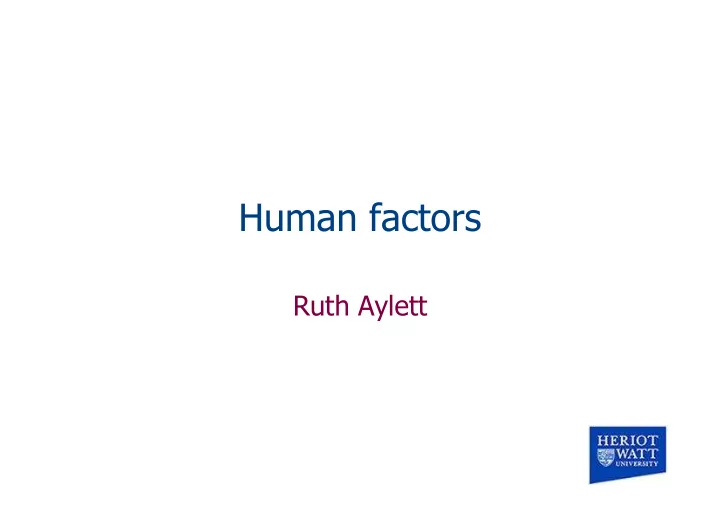

Human factors Ruth Aylett
Topics Human senses and their limitations – Sight – Hearing – Touch – Vestibular system Health and safety issues
Why are human factors important? Human capabilities define desired technology attributes Different senses have different data rates Guidelines for best display and organisation of information for understanding Health and safety issues Predict overall impact of a VE
Human senses Visual Auditory Tactile Olefactory Vestibular (balance) Others: – Proprioception: sense of position and movement of body
Visual perception Field of view (FOV) Acuity – Resolution – Dark v light Stereopsis – Depth cues – Binocular rivalry/eye dominance
Vision
Visual process Light enters through cornea/pupil – Focused by lens on retina – Lens has to adjust focus: accommodation • Uses ciliary muscles Responds to a narrow band of electromagnetic radiation – 400nm to 700nm, overall peak at 559nm – Well-matched to spectral emission of sunlight Response from single photon to fluxes one trilliontimes stronger
Visual process cont. Colour – Via RGB cones ( rods do night vision) • Three kinds of cones, sensitive to different wavelengths – “ long ” : 575nm, about 64% – “ middle ” : 535nm, about 32% – “ short ” : 445nm, • Peripheral cells very sensitive to movement Blind spot – Where optic nerve emerges Eye in permanent motion – Saccades at about 4Hz – Stabilized images disappear – Saccadic suppression leaves these motions largely unnoticed
FOV Horizontally – -59˚ to +110˚ – 118º overlap where stereopsis occurs Vertically – -70˚ to +56˚ Visual acuity – Can separate 2 bright light points 1.5mm apart at 10m – 40 ’’ of arc; 2 µ m on retina – To match this, requires “ typical ” desktop display of 4800x3840 (18.4 million pixels ) Light to dark adaptation: 25000:1 Visual persistence – Critical fusion frequency: c 20 Hz
Visual processing
Stereopsis
The geometry Can detect depth distances of 0.05m at .5m or 4mm at 5m Represented as: θ D =IPD ⎡ Δ r ⎤ — —— r ⎣ r + Δ r ⎦ IPD= Inter-Pupil Distance
Stereo cues Motion parallex cues – Image speed across the retina to judge depth – Only needs one eye (Con)vergence – How much eyes turn in Perspective depth cues – Where we ‘ know ’ the size of an object Textural cues – Light and shadow – Very important for greater distances
Oculomotor cues Accommodation – Physical stretching and relaxing of the lens – Parallel rays entering the relaxed eye will focus on the retina – Relaxed eye has a depth of field of 6m to infinity – To focus objects within 6m it is necessary to alter the optical system of the eye Vergence – Rotation of the eyes (convergence: inward rotation corresponding to viewing closer object) – Muscular feedback in converging and focusing the eyes is cue to the depth of viewed object – Relatively weak, but coupled depth cues!
Hearing Air vibrations (rapid changes in air pressure) converted to mechanical vibrations in middle ear Sound has: – Amplitude: Magnitude of the pressure variation – Frequency: Pressure variation rate – Phase Acoustic reflex: Adaptation to high-intensity sounds; temporarily reduced auditory sensitivity Acoustic stimuli necessarily have temporal component Constant sounds drop out of conscious awareness Sounds are perceived from sources in all directions
Localisation Different factors influence ability to perceive location of sound sources – Interaural level difference: Difference in volume of sound reaching each ear – Interaural time difference:Time difference of sound reaching each ear (sound is slow) – Motion cues • Doppler effect: Frequency shift resulting from relative motion between sound source and observer • Changing volume:Sound perceived as approaching when volume gradually increases (and vice versa)
External ear - pinnae Why do stereo speakers reproduce the original sound stage? – Effect of head + pinnae – Hence in-ear speakers produce stage ‘ inside head ’ Head-related transfer functions (HRTF) – Modify signal – Simulate effect of head and pinnae
Haptic perception Touch is a mechanical or thermal contact with the skin. Mechanical stimuli produce sensation of touch: – Displacement of skin over an extended period – Transitory (milliseconds) displacement of skin – Transitory displacement repeated at constant or variable frequency – Different below-skin sensors for skin with/without hair Also thermal sensing Difficult to characterize in quantitative way Sensations of skin adapt with exposure to stimuli
Skin
Force sensing Receptors in muscles and joints – Inside the body Perception of movement, position, and torque of limbs and other body parts Varying joint angles and muscular length
Vestibular system Movement and orientation in space – See http://en.wikipedia.org/wiki/ Vestibular_system Inner ear: vestibulum – Orthogonal canals for rotation – Saccule/utricle for linear acceleration
Vestibulo-occular reflex To be able to see while moving – Push-pull between RH and LH canals – 3 neurons link to eye – <10 ms lag in eye for head movement
Health and safety issues Flicker – Can trigger epilepsy Eyestrain – Dissociation of accommodation and convergence – Lack of visual calibration, especially HMDs Use of laser light Movement injuries
Cybersickness Reverse form of motion sickness – Conflicting signals from visual and vestibular systems Caused by: – Vection: illusion one is moving in a VE – Lag: delay in visual feedback • Especially bad in HMDs – FOV: wide and narrow. Impacts vection – Lack of interactive control
Symptoms Vestibular disturbances – Head spinning Reduced hand-eye coordination Nausea Effects take time to reduce after exposure Nervous system does adapt
Recommend
More recommend